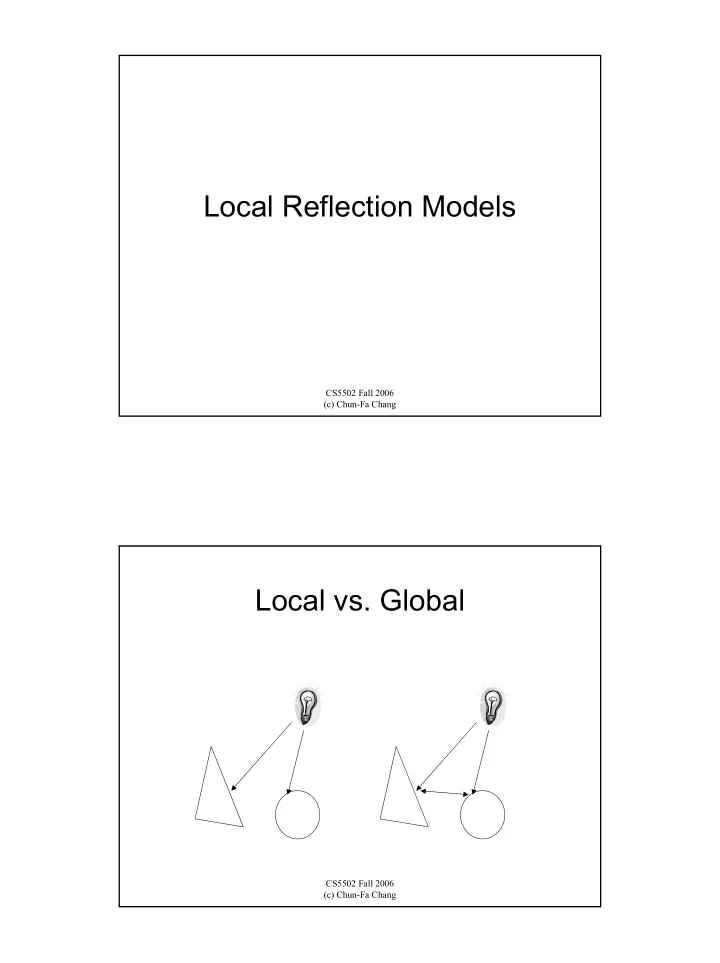

Local Reflection Models CS5502 Fall 2006 (c) Chun-Fa Chang Local vs. Global CS5502 Fall 2006 (c) Chun-Fa Chang
Phong Reflection Model • I = Ka*Ia + kd*Id + Ks*Is specular diffuse ambient • Not completely correct, but good enough. CS5502 Fall 2006 (c) Chun-Fa Chang Ambient Component • Accounting for light scatter around. • Ia is constant. CS5502 Fall 2006 (c) Chun-Fa Chang
Diffuse Component • Id = Ii * N·L • Not affected by viewing direction. – i.e., incoming light is reflected L to all directions. N CS5502 Fall 2006 (c) Chun-Fa Chang Glossy (Specular) Component (Phong Reflection Model) • To model imperfect reflection. • Is = Ii(N · H) n L H N V CS5502 Fall 2006 (c) Chun-Fa Chang
Summary of Phong Reflection Model • I = Ka*Ia + kd*Id + Ks*Is = Ka*Ia + {Kd*(N · L)+ Ks* (N · H) n } * Ii • Where is color? Set Ka and Kd for RGB. Ir = Ka_r*Ia + {Kd_r*(N · L)+ Ks_r* (N · H) n } * Ii Ig =Ka_g*Ia + {Kd_g*(N · L)+ Ks_g* (N · H) n } * Ii Ib =Ka_b*Ia + {Kd_b*(N · L)+ Ks_b* (N · H) n } * Ii • Ka and Kd depend on material color, Ks depends on the light (which is white in the above case). CS5502 Fall 2006 (c) Chun-Fa Chang Phong Reflection Model (continued) • We had: Ir = Kar*Ia + {Kdr*(N · L)+ Ksr* (N · H) n } * Ii Ig =Kag*Ia + {Kdg*(N · L)+ Ksg* (N · H) n } * Ii Ib =Kab*Ia + {Kdb*(N · L)+ Ksb* (N · H) n } * Ii • Alternatively: I ={Ka*Ia + Kd*Ii*(N · L)} * object_color + Ks* Ii*(N · H) n * light_color CS5502 Fall 2006 (c) Chun-Fa Chang
“But, they all look like plastic…” CS5502 Fall 2006 (c) Chun-Fa Chang Specular Component (Cook & Torrance Model) • Consider specular reflection as perfect reflection of micro-facets. (See Watt’s Section 7.6) • Specular= DGF /( N·V) D: Distribution term G: Geometry (shadowing and masking) term F: Fresnel term CS5502 Fall 2006 (c) Chun-Fa Chang
D Term (Cook & Torrance) • Modeling the distribution of micro- geometry. • Gaussian distribution can be used: D = k e -( α /m)2 CS5502 Fall 2006 (c) Chun-Fa Chang G Term (Cook & Torrance) CS5502 Fall 2006 (c) Chun-Fa Chang
The Fresnel Term • Color and ratio of reflected/transmitted light vary with the incident and viewing angles. • Detailed in Pharr’s 9.2.1 and Watt’s 7.6.4 CS5502 Fall 2006 (c) Chun-Fa Chang From Watt’s color plate Figure 7.8. These would be difficult to obtain by fine- tuning the parameters in Phong model. CS5502 Fall 2006 (c) Chun-Fa Chang
“Now, are all materials covered?” No! Let’s try a sample-based method instead… CS5502 Fall 2006 (c) Chun-Fa Chang BRDF • BRDF=f( θ in , φ in , θ ref , φ ref )=f(L,V) CS5502 Fall 2006 (c) Chun-Fa Chang
Watch Out for Subtly in BRDF! • Ask yourself these questions: – Why not just consider N · H as in the Phong’s glossy term? (Hint: Does incidence matter?) – Does φ in really matter? Difference between isotropic and anisotropic reflection! CS5502 Fall 2006 (c) Chun-Fa Chang Why Not Always Using BRDF? • Difficult to find a “closed form” representation of BRDF. • The Phong model and Cook & Torrance model are approximation of BRDF. – They are not 100% match of BRDF, but they are easy to compute. CS5502 Fall 2006 (c) Chun-Fa Chang
Other Reflection Models • Pharr’s 9.4: other microfacet models – Oren-Nayar – Torrance-Sparrow – Blinn microfacet distribution – Anisotropic microfacet model • Pharr’s 9.5: Lafortune model • Models for particular materials: e.g., for finished wood (in SIGGRAPH 2005) CS5502 Fall 2006 (c) Chun-Fa Chang Lafortune Model • Phong model assumes the glossy reflection (lobe) appears in the direction opposite to the incident light. • This assumption is relaxed in the Lafortune model. • Multiple lobes can be used. CS5502 Fall 2006 (c) Chun-Fa Chang
Gouraud Shading and Phong Shading • Gouraud and Phong shadings are interpolative techniques for rasterization. – Polygon vertices are shaded first. – Vertex colors are then interpolated to the interior pixels. CS5502 Fall 2006 (c) Chun-Fa Chang
Recommend
More recommend